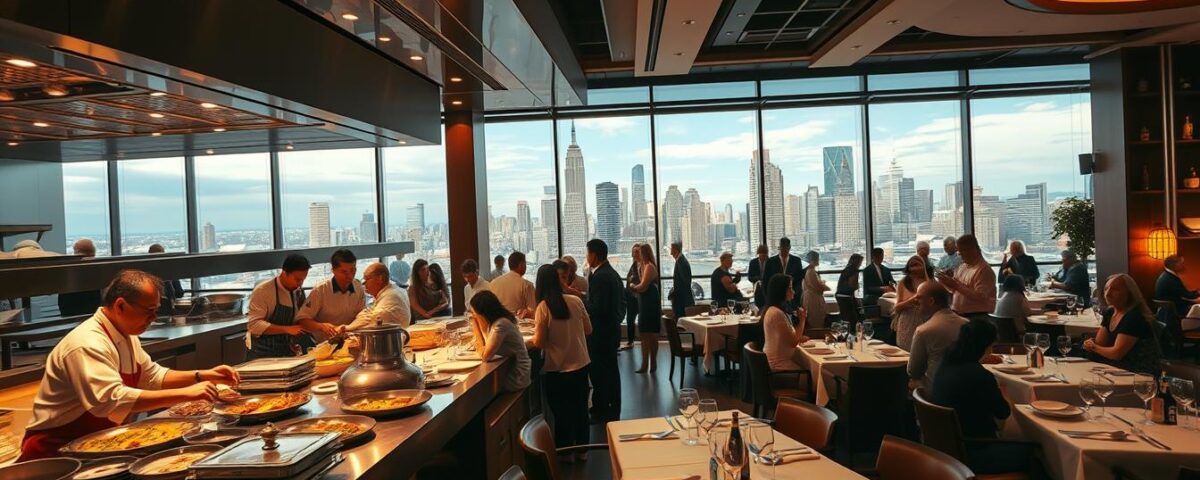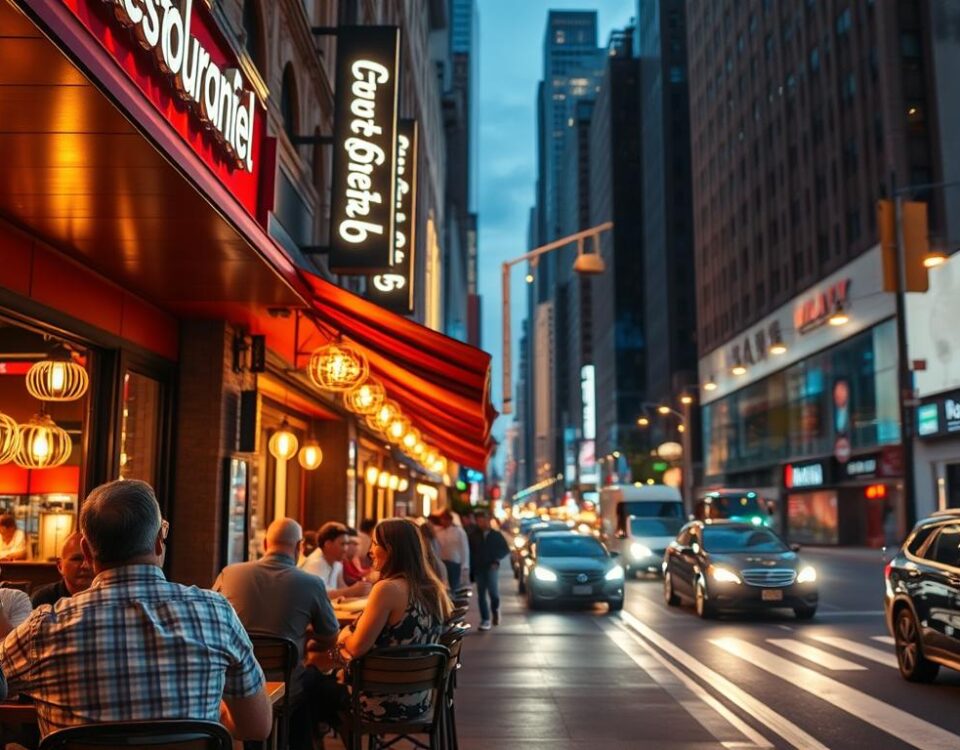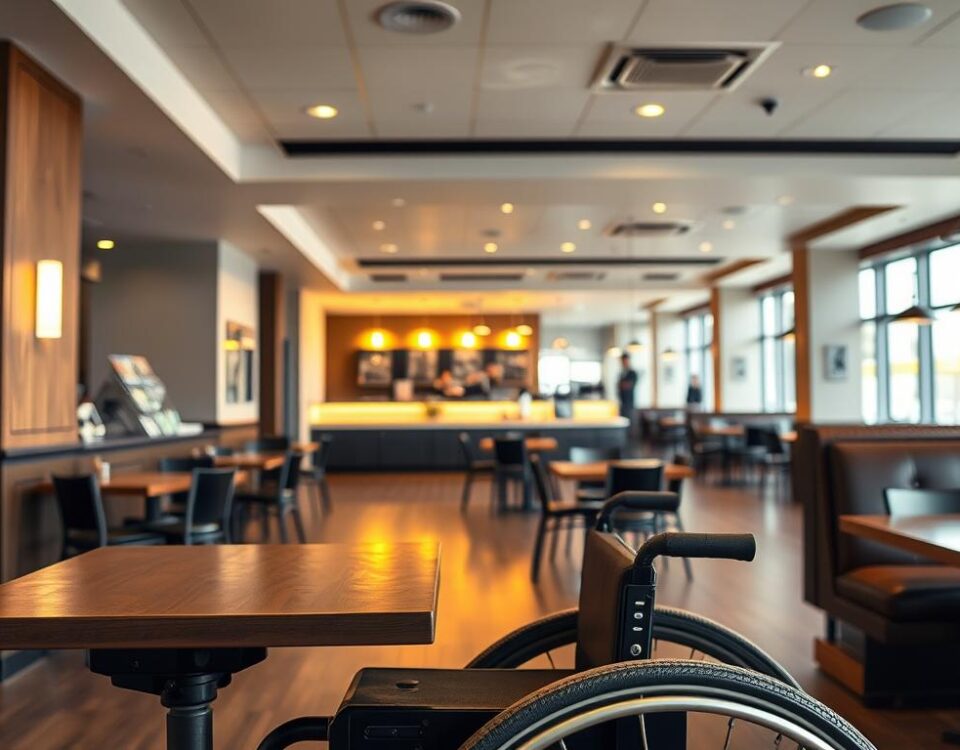
6 Hidden Restaurant Marketing Tactics for Immediate Traffic Boost
July 28, 2025Starting a new restaurant can be a thrilling yet daunting venture. I recall a friend who invested years of passion into launching their dream café, only to face unexpected financial strain. Did you know that approximately 60% of new restaurants fail within the first year? This stark reality underscores the importance of thorough planning and preparation.
To navigate this complex journey, you’ll need a comprehensive business plan, a deep understanding of the local market, and a keen eye for talent. My guide will walk you through the essential steps, from defining your concept to securing licenses and permits, and creating a profitable menu that delights your customers. What sets successful restaurants apart, and how can you position yours for long-term success?
Key Takeaways
- Understand the local market and competition
- Create a comprehensive business plan
- Secure necessary licenses and permits
- Develop a profitable menu
- Build a skilled and dedicated team
The Reality of Starting a Restaurant Business
Starting a restaurant business is a complex venture that goes beyond serving great food. It’s about creating an experience that keeps people coming back.
As you embark on this journey, it’s crucial to understand the rewards and challenges that come with owning a restaurant. The industry offers incredible opportunities for creative expression and business growth, but it also demands long hours, thin profit margins, and effective staffing.
The Rewards and Challenges
The restaurant industry is known for its potential financial success when managed properly. However, it’s also marked by a high failure rate, making it essential to understand the challenges you’ll face. From competitive pressures to staffing issues, the obstacles are numerous.
- Running a restaurant requires a balance of creative vision and practical operational skills.
- Timing is critical in restaurant operations, affecting every aspect of your business.
What Makes a Successful Restaurant
A successful restaurant is not just about serving good food; it’s about creating memorable experiences that keep people coming back. This involves consistent operations, financial management, and exceptional customer service.
To achieve long-term success, you need to balance your passion with business acumen, ensuring that your restaurant is well-managed and financially stable over time.
Defining Your Restaurant Concept
The concept of your restaurant is the foundation upon which your entire business is built. It influences every decision, from the menu and pricing to the decor and service style. A well-defined concept helps create a consistent experience for your customers and makes operational decisions clearer.
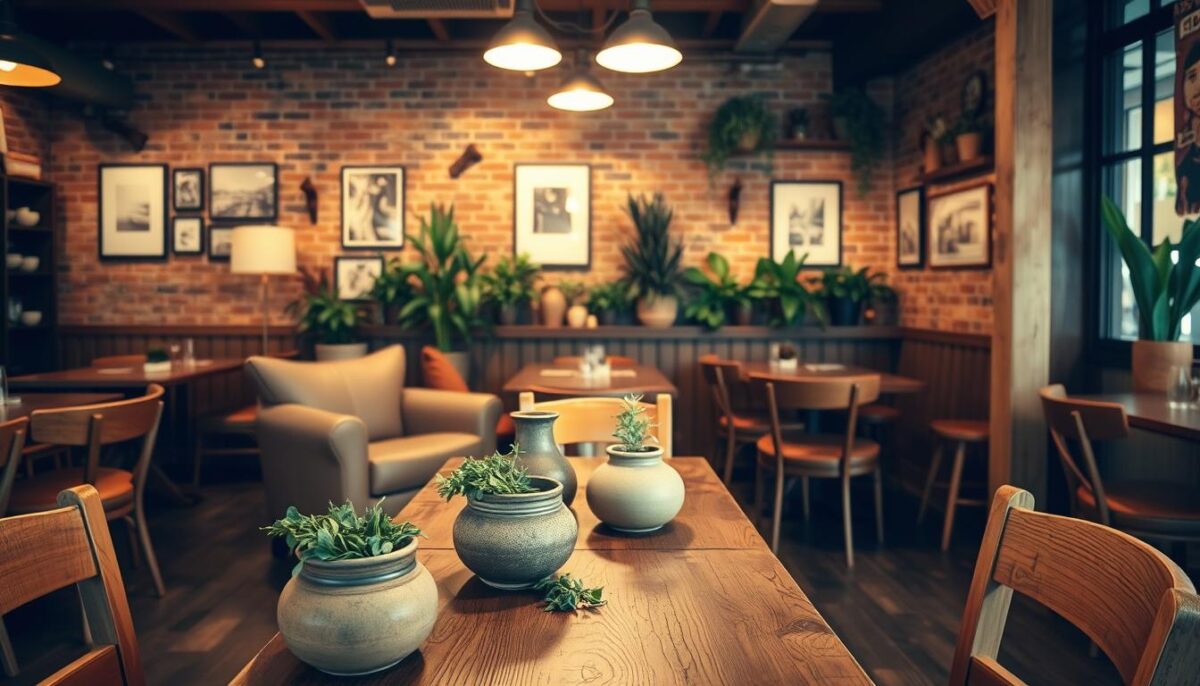
Finding Your Unique Selling Proposition
Your unique selling proposition (USP) is what differentiates your restaurant in a competitive market. To identify your USP, you need to understand your target audience and what they are looking for in a dining experience. Consider what makes your food or service unique and emphasize those qualities.
For example, you might specialize in a particular cuisine or offer exceptional value for money. Whatever your USP is, it should be a key part of your restaurant’s identity and marketing strategy.
Popular Restaurant Service Styles
Restaurants are classified into three primary categories: quick-service, midscale, and upscale. Quick-service restaurants, also known as fast-food establishments, offer limited menus at relatively low prices. Midscale restaurants provide a balance between quality and affordability, while upscale restaurants focus on high-end cuisine and service.
- Quick-service: Fast food with limited menus.
- Midscale: Balance between quality and price.
- Upscale: High-end cuisine and service.
Food Concepts and Cuisine Types
Your food concept and cuisine type are crucial elements of your restaurant’s identity. Whether you’re serving Italian, Mexican, or fusion cuisine, your concept should align with your target market and business goals. Consider the market opportunities and potential challenges for your chosen cuisine.
For instance, a specific cuisine might be particularly popular in your area, or you might identify a gap in the market for a certain type of cuisine. Authenticity is key; ensure that your concept aligns with your passion and expertise.
Understanding Your Target Market
Before opening your restaurant, it’s essential to understand the demographics and preferences of your potential customers. This knowledge will help you tailor your offerings to meet their needs, increasing your chances of success in a competitive market.
Understanding your target market is not just about knowing who they are; it’s also about understanding what they want from a dining experience. This involves analyzing demographic data and conducting market research to gain valuable insights into customer preferences and behaviors.
Demographic Analysis
Demographic analysis is a critical step in identifying your target market. It involves examining data on age, income, education level, and other factors to determine the characteristics of your potential customers. For instance, different generational groups have distinct dining preferences: Generation Z might prefer sustainable and vegan options, while Baby Boomers might be more interested in traditional cuisine.
| Generational Group | Dining Preferences |
|---|---|
| Generation Z | Sustainable, vegan options |
| Millennials | Experiential dining, diverse cuisine |
| Baby Boomers | Traditional cuisine, comfort food |
Market Research Techniques
Effective market research techniques are vital for understanding your target market. These can include surveys, focus groups, and data analysis to gather both quantitative and qualitative insights. By using these techniques, you can identify gaps in the market that your restaurant can fill, differentiating yourself from competitors.
For example, conducting surveys can help you understand customer preferences, while focus groups can provide more in-depth insights into their dining experiences and expectations. By combining these research methods, you can develop a comprehensive understanding of your target market and create a restaurant concept that resonates with them.
By focusing on a specific segment of the market and tailoring your restaurant concept to their needs, you can increase your chances of success. Remember, trying to appeal to everyone is a recipe for failure; instead, focus on the 5 or 10% of the target market that you can effectively serve.
Creating a Comprehensive Restaurant Business Plan
Crafting a comprehensive business plan is crucial for the success of any restaurant venture. As the cornerstone of your business, it outlines your strategy, goals, and financial projections, serving as a roadmap for decision-making and a tool to measure progress.
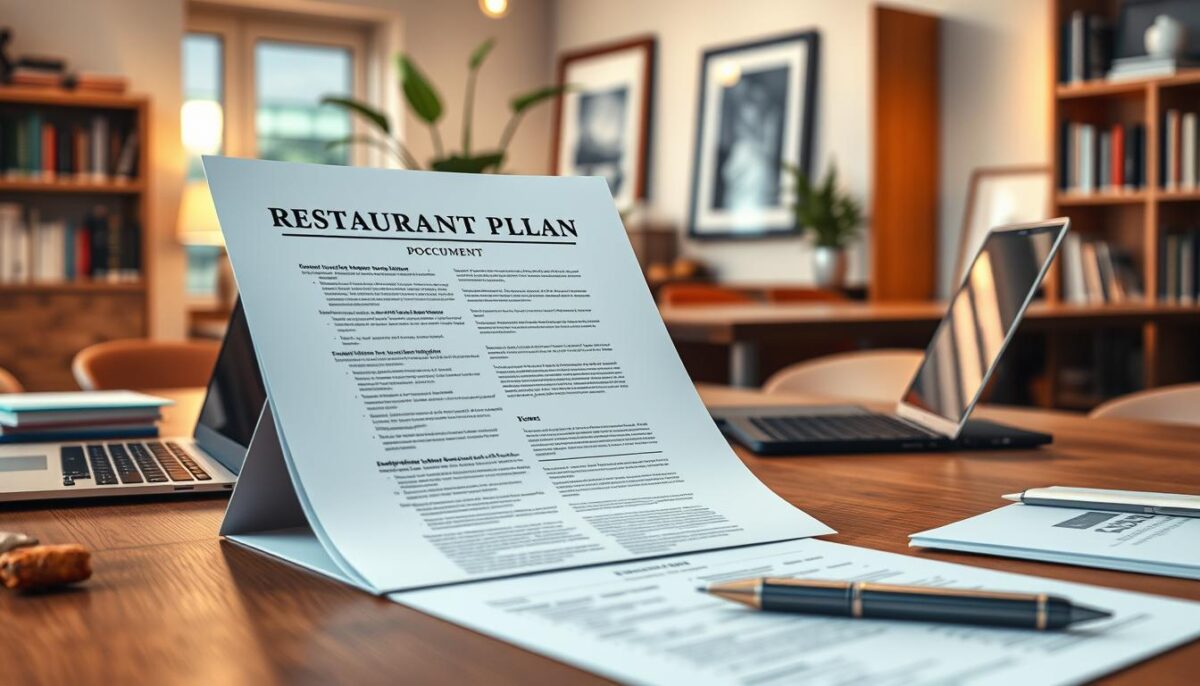
Essential Components of Your Plan
A well-structured business plan includes several key elements. It should start with an executive summary that encapsulates your restaurant’s concept, mission, and objectives. This is followed by a detailed market analysis, including demographic analysis and market research techniques to understand your target audience and competitors.
Your plan should also outline your marketing strategy, operational plan, and management structure. This comprehensive approach ensures that you have considered all aspects of your business, from the menu and pricing to staffing and customer service.
Financial Projections and Break-Even Analysis
Financial projections are a critical component of your business plan, providing a forecast of your restaurant’s financial performance. This includes projected income statements, balance sheets, and cash flow statements. A break-even analysis is also essential, as it helps you determine when your restaurant will become profitable.
To create realistic financial projections, you’ll need to consider various factors, including startup costs, ongoing operational expenses, and revenue streams. This detailed financial planning will help you manage your finances effectively and make informed decisions about your business.
Exit Strategy Planning
While it may seem counterintuitive to plan your exit strategy when you’re just starting your restaurant journey, it’s an important aspect of your business plan. An exit strategy outlines your plans for leaving the business, whether through sale, merger, or closure. This forward-thinking approach can help you make strategic decisions that enhance the long-term value of your restaurant.
By including an exit strategy in your business plan, you can ensure that you’re prepared for any eventuality, whether you’re looking to retire, pursue new opportunities, or adapt to changing market conditions.
Restaurant Startup Costs Breakdown
Starting a restaurant is a significant financial undertaking that requires careful planning and budgeting. To ensure the success of your venture, it’s crucial to understand the various costs involved in opening and running a restaurant.

Initial Investment Requirements
The initial investment for a restaurant includes several key components. Lease deposits, construction or renovation costs, equipment purchases, licenses, and initial inventory are some of the major expenses you’ll need to consider. For instance, the cost of leasing a space can vary significantly depending on the location, with suburban areas generally being more affordable than city centers. According to Bright Ideas Trust, the monthly rent in suburban London can range from £10 to £20 per square foot.
To give you a better idea, a fine dining restaurant might require about 20 square feet per person, while a more casual establishment might need around 10 square feet per person. These costs can add up quickly, and it’s essential to budget accordingly.
Ongoing Operational Expenses
Once your restaurant is up and running, you’ll need to manage ongoing operational expenses. These include rent, utilities, food costs, labor, insurance, and marketing expenses. The size, concept, and location of your restaurant will significantly impact these costs. For example, a restaurant in a high-traffic area will likely have higher labor and marketing expenses compared to one in a quieter location.
It’s vital to regularly review and adjust your operational expenses to ensure they align with your business goals and budget.
Cost-Saving Strategies
Implementing cost-saving strategies can help you manage your expenses without compromising your restaurant’s concept or customer experience. One approach is to optimize your menu engineering to reduce food costs. You can also explore energy-efficient equipment to lower utility bills and negotiate with suppliers to secure better deals.
By being mindful of your expenses and exploring ways to save, you can improve your restaurant’s financial health and increase its chances of long-term success.
Financing Your Restaurant Dream

Financing a restaurant is a crucial step in turning your business idea into a reality. The amount of money needed to start a restaurant can vary greatly depending on the type of business, facility, equipment, inventory, marketing, and necessary operating capital.
Traditional Funding Sources
Traditional funding sources for restaurants include bank loans, SBA loans, and investments from friends and family. Bank loans can provide a significant amount of capital, but often require a solid business plan and collateral. SBA loans offer favorable terms, such as lower interest rates and longer repayment periods, making them an attractive option for restaurant owners.
Alternative Financing Options
Alternative financing options are becoming increasingly popular among restaurant owners. Crowdfunding allows you to raise funds from a large number of people, typically through online platforms. Restaurant-specific lenders offer financing tailored to the unique needs of the industry. Equipment leasing is another option, allowing you to use necessary equipment without the upfront cost of purchasing.
Creating an Attractive Package for Investors
To secure financing, you’ll need to create an attractive investment package that showcases your restaurant concept, business plan, and financial projections. This package should demonstrate your understanding of the market, your target audience, and your strategy for success. By presenting a clear and compelling case, you can attract investors and lenders who are confident in your ability to succeed.
Choosing the Perfect Restaurant Location
Finding the perfect spot for your restaurant is a balancing act between affordability and visibility. The location of your restaurant can make or break your business, regardless of how good your food and service might be. A well-chosen location can attract a loyal customer base, while a poorly chosen one can lead to financial struggles.
Foot Traffic and Accessibility
When evaluating potential locations, it’s crucial to consider foot traffic and accessibility. A spot with high foot traffic can increase visibility and attract more customers. Look for areas with good public transport links or those that are within walking distance to a large target market. For instance, a restaurant near a busy shopping district or office area can benefit from the natural flow of potential customers.
Analyzing the Competition
Understanding the competitive landscape is vital when choosing a location for your restaurant. Analyze the types of businesses already in the area and identify any gaps in the market. For example, if there’s a street full of restaurants but none offer vegan or vegetarian options, this could be a niche to fill. Use this information to determine whether your restaurant concept can stand out and attract customers.
| Location Factor | Importance | Considerations |
|---|---|---|
| Foot Traffic | High | Visibility, Accessibility |
| Competition | High | Market Gaps, Unique Selling Proposition |
| Lease Terms | Medium | Rent, Term Length, Build-out Allowances |
Lease Considerations and Negotiations
Once you’ve identified a potential location and evaluated the competition, it’s time to consider the lease terms. Negotiating a favorable lease can protect your restaurant business in both good times and challenging periods. Key considerations include the term length, rent increases, and build-out allowances. Ensure you understand all the terms before signing the lease to avoid any surprises down the line.
By carefully evaluating these factors and choosing the right location for your open restaurant, you can set your business up for success and create a thriving dining experience for your customers.
Navigating Licenses and Permits

Opening a restaurant in the U.S. requires navigating a complex web of licenses and permits. Ensuring compliance with these regulations is crucial for avoiding fines, penalties, and even forced closure.
Food Service Licenses
To operate a restaurant, you’ll need to obtain a food service license from your local health department. This license ensures that your establishment meets health and safety standards. The process typically involves an inspection of your premises to verify compliance with food handling and preparation regulations.
Liquor Licenses
If you plan to serve alcohol, you’ll need to secure a liquor license. There are various types of liquor licenses, each with its own set of requirements and costs. The process can be lengthy, so it’s essential to apply early to avoid delays in your opening.
Health Department Regulations
Your restaurant must comply with health department regulations, including food safety standards and regular inspections. Maintaining a clean and safe environment is not only a legal requirement but also crucial for customer trust and loyalty.
In addition to these licenses, you may also need to obtain other permits, such as business licenses, sign permits, and certificates of occupancy. Understanding the specific requirements for your restaurant and location is key to navigating this complex process efficiently.
Designing Your Restaurant Space
Creating an inviting and functional restaurant space requires careful planning and attention to detail. The design of your restaurant is crucial not just for aesthetics but for operational efficiency and profitability.
Layout and Floor Plan Considerations
When designing your restaurant’s layout, it’s essential to maximize seating capacity while ensuring comfortable space for both customers and staff. Consider the flow of traffic, the placement of tables, and the overall ambiance you want to create.
Kitchen Design and Workflow
An efficient kitchen design is vital for improving workflow, reducing staff frustration, and speeding up service. Consider the principles of a well-designed kitchen, including the placement of equipment, workflow, and storage.
| Design Element | Considerations | Benefits |
|---|---|---|
| Natural Light | Maximize natural light where possible | Enhances ambiance, reduces energy costs |
| Ventilation | Ensure proper ventilation in kitchen and dining areas | Improves air quality, comfort |
| Acoustic Treatments | Use sound-absorbing materials | Reduces noise levels, enhances dining experience |
Creating the Right Ambiance
The ambiance of your restaurant is crucial for creating the right atmosphere for your customers. Consider using lighting, color, sound, and decor choices that align with your concept to enhance the dining experience.
By balancing design aesthetics with practical considerations like durability, maintenance, and budget constraints, you can create a restaurant space that tells a cohesive story, reinforces your brand, and enhances the dining experience for your customers.
Essential Restaurant Equipment and Supplies

A well-equipped restaurant is the backbone of a successful dining experience. To ensure a smooth operation, it’s vital to have the essential restaurant equipment in place. This includes kitchen equipment, front-of-house necessities, and technology that streamlines operations.
Kitchen Equipment Essentials
The right kitchen equipment is crucial for preparing high-quality dishes. This includes cooking appliances such as ovens, stoves, and grills, as well as refrigeration units and food prep tools. When selecting kitchen equipment, consider your menu type, production volume, and available space.
Front-of-House Necessities
The front-of-house area is where customers interact with your restaurant, so it’s essential to create a welcoming atmosphere. This includes furniture, tableware, serving equipment, and decor elements that reflect your brand’s identity. Consider the comfort and aesthetic appeal of your front-of-house necessities to enhance the dining experience.
Technology and POS Systems
Modern restaurant technology, particularly point-of-sale (POS) systems, can significantly improve efficiency and provide valuable business insights. A POS system can help with inventory tracking, tipping, employee timecards, and data analytics. When choosing a POS system, consider its ability to integrate with other restaurant operations and its scalability to grow with your business.
To reduce equipment costs, consider leasing, buying used, or phasing purchases over time. It’s also essential to determine the right equipment specifications based on your menu, space constraints, and production volume. By investing in the right equipment and technology, you can create an efficient kitchen layout that minimizes staff movement and maximizes productivity.
Crafting a Profitable Menu
Your menu is more than just a list of dishes; it’s a strategic tool that can significantly impact your restaurant’s profitability. A well-crafted menu balances food costs, perceived value, and competitive positioning to maximize profits while satisfying customers.
Menu Engineering Basics
Menu engineering is the art and science of designing menus to maximize profits. It involves analyzing the profitability of each menu item and making data-driven decisions about which items to keep, modify, or remove. By understanding the food costs and popularity of each dish, you can optimize your menu for profitability.
| Menu Item | Food Cost | Price | Profitability |
|---|---|---|---|
| Grilled Chicken | $3.50 | $15.00 | High |
| Veggie Burger | $2.50 | $12.00 | Medium |
| Salmon | $4.00 | $18.00 | High |
Pricing Strategies
Effective pricing strategies are crucial for balancing food costs, perceived value, and competitive positioning. You can use techniques like value-based pricing, competitive pricing, or cost-plus pricing to determine the optimal price for your menu items.
Menu Design and Psychology
The design and layout of your menu can significantly influence customer choices. By using psychological principles like menu item placement, pricing presentation, and descriptive language, you can subtly guide customers towards high-profit items and enhance the overall dining experience.
By crafting a profitable menu, you can increase revenue, reduce food costs, and improve customer satisfaction. Regularly analyzing menu performance and making data-driven decisions will help you stay competitive in the market.
Building Your Opening a Restaurant Guide Team
Building a strong team is a foundational step in opening a successful restaurant. Your team is arguably your most important asset, and assembling the right people will help ensure your restaurant’s success.
Key Staff Positions
To run your front and back of house efficiently, you’ll need to fill several key staff positions. These include management roles like a restaurant manager and assistant managers, kitchen staff such as head chefs, sous chefs, and line cooks, and front-of-house personnel including servers, bartenders, and hosts/hostesses. Each of these roles is crucial to providing a smooth and enjoyable dining experience for your customers.
Hiring and Training Strategies
Effective hiring strategies are critical in the restaurant industry. You’ll want to look for candidates with relevant experience and a passion for delivering excellent service. Once you’ve assembled your team, comprehensive training programs are essential to ensure consistent service and food quality. This includes both initial training and ongoing development opportunities to keep your staff motivated and skilled.
Creating a Positive Work Culture
Creating a positive work culture is vital to reducing the high turnover rates common in the restaurant industry. This involves fostering an environment where staff feel valued, supported, and motivated. Strategies include recognizing employee achievements, providing opportunities for growth, and ensuring clear communication between management and staff. By doing so, you’ll not only improve staff retention but also enhance the overall customer experience.
By focusing on building a strong team, you’ll be well on your way to creating a successful restaurant that attracts and retains customers.
Marketing Your New Restaurant

Marketing your new restaurant effectively requires a blend of traditional and digital strategies to reach and engage your target audience. In today’s competitive business landscape, it’s crucial to stand out and create a lasting impression on potential customers.
Pre-Opening Marketing Tactics
Before you even serve your first customer, you can build anticipation and awareness through pre-opening marketing tactics. Utilize social media platforms to share behind-the-scenes content, sneak peeks, and updates about your restaurant‘s progress.
Grand Opening Strategies
With a soft opening under your belt and a marketing campaign in full swing, it’s time to make a splash with your grand opening. Focus on creating an experience that will leave a lasting impression on your customers, making them want to return.
Building a Loyal Customer Base
To ensure the long-term success of your restaurant business, focus on building a loyal customer base. Implement loyalty programs, gather feedback, and consistently engage with your customers to improve your offerings and strengthen customer relationships.
By developing a comprehensive marketing plan that includes both traditional and digital channels, you can effectively promote your restaurant and attract a loyal following. Remember, the key to success lies in creating a memorable experience for your customers and continually adapting your strategy based on their feedback and preferences.
Common Pitfalls to Avoid When Opening a Restaurant
Opening a restaurant can be a thrilling venture, but it’s crucial to be aware of the potential pitfalls that can lead to failure. As you navigate the complex process of opening a restaurant, understanding the common mistakes that new owners make can help you avoid costly errors and ensure the success of your business.
Financial Mistakes
One of the most significant financial mistakes new restaurant owners make is undercapitalization. Starting a restaurant can cost anywhere from $95,000 to over $2 million, and having sufficient funds is crucial to cover initial expenses and ongoing operational costs. Poor cash flow management and inaccurate cost projections can also lead to financial difficulties. To avoid these mistakes, it’s essential to create a comprehensive business plan that includes detailed financial projections and a contingency fund to cover unexpected expenses.
| Financial Mistake | Consequence | Solution |
|---|---|---|
| Undercapitalization | Insufficient funds to cover expenses | Create a comprehensive business plan with detailed financial projections |
| Poor Cash Flow Management | Inability to meet financial obligations | Implement effective cash flow management strategies |
| Inaccurate Cost Projections | Unexpected expenses and financial strain | Conduct thorough market research and analysis |
Operational Errors
Operational errors can also have a significant impact on a restaurant’s success. Inefficient processes, poor inventory management, and inadequate staff training can lead to decreased productivity, increased costs, and a negative customer experience. To avoid these mistakes, it’s essential to implement efficient operational systems, invest in staff training, and monitor inventory levels closely.
Marketing Missteps
Marketing missteps can also be detrimental to a restaurant’s success. Targeting the wrong audience, inconsistent branding, and ineffective promotion can lead to a lack of visibility and a failure to attract customers. To avoid these mistakes, it’s crucial to develop a marketing strategy that is tailored to your target audience, maintains a consistent brand image, and utilizes effective promotional channels.
By being aware of these common pitfalls and taking steps to avoid them, you can increase your chances of success in the competitive restaurant industry.
Conclusion
As we conclude this comprehensive guide, you’re now equipped with the knowledge to turn your restaurant vision into a reality. This guide has covered everything from creating a new business plan to setting up operations and marketing your restaurant. By following this guide step by step, you can open a restaurant that will attract customers for years to come.
You now have a roadmap to follow as you embark on your restaurant ownership journey, with practical advice for each stage of the process. I want to emphasize that while opening a restaurant is challenging, the rewards of creating memorable dining experiences for people can be immensely fulfilling. Proper planning is crucial – take your time developing a solid business plan that will guide your decisions and help secure financing.
It’s essential to be realistic about the time commitment required – restaurant ownership is not a 9-to-5 job but a lifestyle that demands dedication. Make sure you have adequate capital not just to open your restaurant but to sustain it through the initial period before profitability. I believe that success in the restaurant business comes from a combination of passion, business acumen, and willingness to adapt.
Don’t forget that your customers’ experience should always be your priority – happy customers become loyal patrons who spread the word. I hope this guide has given you everything you need to know about opening a restaurant and prepared you for the exciting journey ahead. Many successful restaurant owners faced the same challenges you will – persistence and learning from mistakes are key to joining their ranks.
As you move forward, remember that opening a successful restaurant takes time, effort, and perseverance. With a well-crafted plan and a commitment to excellence, you can create a thriving business that brings joy to your customers and your community.
FAQ
What are the key elements to consider when creating a restaurant business plan?
When creating a comprehensive restaurant business plan, I consider essential components such as market analysis, financial projections, and an exit strategy. A well-structured plan helps me navigate the challenges of starting a successful restaurant business.
How do I determine the ideal location for my restaurant?
To find the perfect location, I evaluate factors such as foot traffic, accessibility, and competition. I also consider lease terms and negotiate the best possible agreement to ensure my restaurant’s success.
What licenses and permits are required to operate a restaurant?
To operate a restaurant, I need to obtain necessary licenses and permits, including food service licenses, liquor licenses, and health department permits. I ensure compliance with all regulations to avoid any potential issues.
How do I create a profitable menu for my restaurant?
To craft a profitable menu, I apply menu engineering basics, pricing strategies, and menu design principles. I also consider my target market’s preferences and dietary needs to create a menu that appeals to my customers.
What are the most significant costs associated with starting a restaurant?
Initial investment requirements, ongoing operational expenses, and cost-saving strategies are crucial to understand when starting a restaurant. I break down my startup costs into equipment, staffing, and marketing expenses to ensure I’m prepared for the financial demands.
How can I effectively market my new restaurant to attract customers?
To market my restaurant, I use pre-opening marketing tactics, grand opening strategies, and focus on building a loyal customer base through social media and customer engagement. I also leverage local marketing initiatives to reach my target audience.
What are some common pitfalls to avoid when opening a restaurant?
When opening a restaurant, I avoid financial mistakes, operational errors, and marketing missteps. I stay focused on my business plan, manage my finances carefully, and continually assess my operations to ensure I’m on track for success.
How do I build a strong team for my restaurant?
To build a strong team, I identify key staff positions, develop effective hiring and training strategies, and foster a positive work culture. I prioritize staff development and retention to ensure my team is motivated and committed to delivering excellent customer service.
